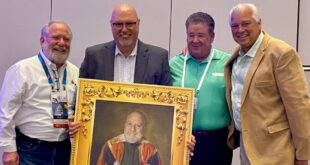Develop Good Relationships
According to NFPA 13, Standard for the Installation of Sprinkler Systems, “the ‘Authority Having Jurisdiction’ [AHJ] is the organization, office or individual responsible for enforcing the requirements of a code or standard or for approving equipment, materials, an installation or a procedure.” It should be no surprise to sprinkler contractors, manufacturers and suppliers, and the engineering community that the “AHJ” plays a pivotal role within the fire sprinkler industry. These authorities may be an individual such as a fire chief, fire marshal, fire prevention officer, water department inspector, health inspector, electrical inspector, building official, or others. In the case of life safety and property protection, the AHJs have been delegated the responsibility of inspecting and accepting the systems that have been installed, and is often a statutory requirement authorized by local, state, or federal laws. Frequently, the authorities with whom we communicate are representatives of the fire service and we know fire service personnel have been known to be strong proponents of fire sprinkler requirements. It should be no surprise that our success as a sprinkler industry is directly connected to having our work inspected where the results provide a positive outcome for the public and all those concerned with the design and installation of the systems we install.
The effect of their reviews, interpretations, and inspections have an impact on the way we design and install our work to the extent that the AHJ controls the final acceptance of the fire sprinkler system. Most bid specifications require our work to be done in accordance with all the AHJs. We also know that in most cases final payment is contingent upon a final inspection by one or more AHJs. It is vitally important that contractors, manufacturers, suppliers, and engineers maintain a professional and working relationship with these representatives of the public who are indebted to no one other than the public for the sake of public safety.
We all have had some strained experiences with AHJs who have interpreted the codes and standards in a way in which we did not agree. A considerable amount of time is invested by contractors, manufacturers and suppliers, and others convincing authorities that we have provided a design, installation, and material selections that are consistent with the applicable codes and standards. The premise and expectation here is that the authority is exposed to continuing education and training in this industry – an industry that is constantly changing with new technological advances. For years, the driving force for this change has been through the research and development departments of manufacturers and suppliers of sprinkler devices and materials used by the sprinkler contracting community. NFPA recognizes this influence when it states in its equivalency section in every NFPA standard that, “Nothing in this standard is intended to prevent the use of systems, methods, or devices of equivalent or superior quality strength, fire resistance, effectiveness, durability, and safety as those prescribed by this standard.”
For the reasons stated above, all authorities who oversee and approve our work must be familiar with the codes, standards, materials, and devices that are used in conjunction with our systems. The American Fire Sprinkler Association (AFSA) offers a variety of training programs and seminars that can assist the AHJ and the fire sprinkler contractor. Additionally, AFSA offers a way to get informal interpretations of a specific code or NFPA standard. Over the last few years AFSA has seen a dramatic increase in Informal Interpretation requests it receives. Most of the interpretations are processed by AFSA’s Technical Services Department with the help and assistance of AFSA codes and standards representatives. These representatives who are appointed by AFSA, attend NFPA standards committee meetings and are well informed as to the reasons for specific standards’ language and current revisions to the standards. So, AFSA members, don’t miss out on this valuable tool. This is a perfect avenue for a sprinkler contractor or AHJ to clarify and validate a position taken in the course of design and installation of a fire sprinkler system.
Last year, AFSA announced the completion of an NFPA 25 ITM Inspector Development Program for contractors and the fire sprinkler community. There are also many other seminars intended to focus directly on AHJ plan review, which also emphasize significant changes within the sprinkler industry. These programs and many more are currently available to the industry and AFSA encourages the AHJ community to participate in these valuable programs as well.
The AHJ must also have confidence in those who are directly involved with the design and installation of fire sprinkler systems. To this end, we encourage our membership to continue to utilize our designer’s courses and apprenticeship courses, and attend AFSA’s one- and two-day seminar series, webinars, and our two-week Beginning Fire Sprinkler System Planning Schools.
AFSA is a great resource for all of the above reasons and many more. You are missing out if you don’t take advantage of these great membership benefits. Visit AFSA’s website at firesprinkler.org for a complete listing and description of all that are currently available.
Continue to work with your local AHJs and if you haven’t already tried, develop the kind of relationship with the enforcement community that fosters trust and confidence.
You are a part of one of the greatest and most rewarding professions available. Utilize what is available and let AFSA play a bigger part in making it even better for you. n
 ABOUT THE AUTHOR: Jack Viola, FPE, is president of JFV Engineering, LLC in South Hadley, Massachusetts. He was instrumental in the formation of AFSA, was on its initial Board of Directors, and has served as Chairman of AFSA’s Board of Directors and on numerous AFSA committees. Viola has experience in all phases of the sprinkler business, starting as an apprentice, then moving on to project manager, sales manager and designer with a NICET Level IV Certification. He was owner and president of HFP Fire Sprinkler Corporation of Westfield, Massachusetts until its sale in 2008. He currently is an NFPA representative on the NFPA 13D, 13R and 15 committees, and was just reappointed as a member of the Massachusetts Bureau of Pipefitters, Refrigeration Technicians, and Sprinkler Fitters. Viola is currently a Massachusetts registered Fire Protection Engineer.
ABOUT THE AUTHOR: Jack Viola, FPE, is president of JFV Engineering, LLC in South Hadley, Massachusetts. He was instrumental in the formation of AFSA, was on its initial Board of Directors, and has served as Chairman of AFSA’s Board of Directors and on numerous AFSA committees. Viola has experience in all phases of the sprinkler business, starting as an apprentice, then moving on to project manager, sales manager and designer with a NICET Level IV Certification. He was owner and president of HFP Fire Sprinkler Corporation of Westfield, Massachusetts until its sale in 2008. He currently is an NFPA representative on the NFPA 13D, 13R and 15 committees, and was just reappointed as a member of the Massachusetts Bureau of Pipefitters, Refrigeration Technicians, and Sprinkler Fitters. Viola is currently a Massachusetts registered Fire Protection Engineer.
 Sprinkler Age A Publication of the American Fire Sprinkler Association
Sprinkler Age A Publication of the American Fire Sprinkler Association

